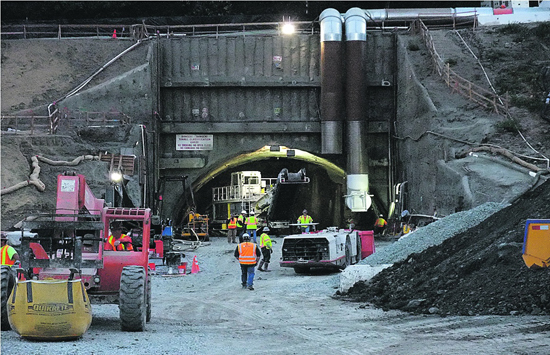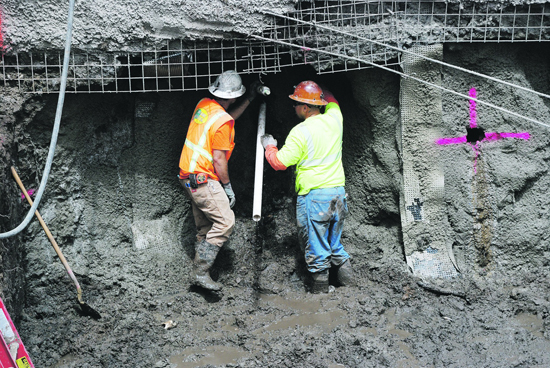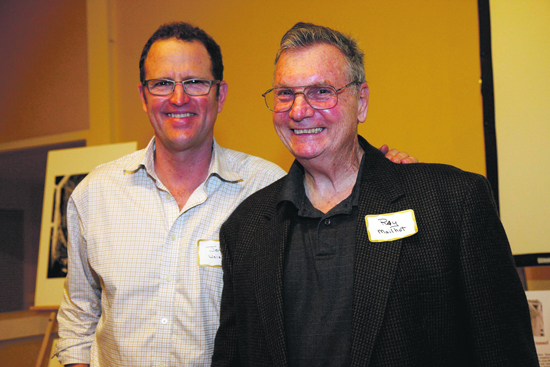| | Published December 8th, 2010
| The Caldecott Tunnel-History in the Making
| | By Andrea A. Firth |  | | Construction on the east side of the 4th bore of the Caldecott Tunnel, October 2010. Photo Albin Reinhart
|
Tunnel building technology has changed significantly since a group of merchants from Oakland pooled their resources to fund the first hand-dug passageway through the hills over 100 years ago. What hasn't changed is how long it takes to tunnel through the dirt and bedrock between Orinda on the east side and Oakland on the west.
 Construction of the 4th bore of the Caldecott Tunnel, which got underway in February of this year, utilizes a new Austrian tunneling method with a sophisticated piece of machinery called a roadheader that was shipped in pieces from Germany and reassembled at the tunnel construction site. It will take about three and half to four years to complete the 4th bore, which is about the same amount of time it took to build bores 1 and 2 of the tunnel in the late 1930's and the third bore in the mid-1960's.
Construction of the 4th bore of the Caldecott Tunnel, which got underway in February of this year, utilizes a new Austrian tunneling method with a sophisticated piece of machinery called a roadheader that was shipped in pieces from Germany and reassembled at the tunnel construction site. It will take about three and half to four years to complete the 4th bore, which is about the same amount of time it took to build bores 1 and 2 of the tunnel in the late 1930's and the third bore in the mid-1960's.
 "Tunnel building is a slow, methodical process," said Jeff Weiss, Public Information Officer for Caltrans, in his presentation about the Caldecott Fourth Bore Project to the attendees of the Orinda Historical Society Annual dinner. Weiss was joined by Ray Mailhot, a 39-year Caltrans veteran and the de facto historian of the Caldecott Tunnel, who shared his experiences as supervisor of the tunnel along with old photos and video footage.
"Tunnel building is a slow, methodical process," said Jeff Weiss, Public Information Officer for Caltrans, in his presentation about the Caldecott Fourth Bore Project to the attendees of the Orinda Historical Society Annual dinner. Weiss was joined by Ray Mailhot, a 39-year Caltrans veteran and the de facto historian of the Caldecott Tunnel, who shared his experiences as supervisor of the tunnel along with old photos and video footage.
 "It was a wet, dark tunnel," said Mailhot, describing the original tunnel that opened in 1903. The 1,040 foot-long tunnel, which was first called the Kennedy Tunnel and later dubbed the Old Broadway Tunnel, was dug from both sides and did not meet in the middle creating a four-foot jog at the center. A few of the dinner attendees recalled going through the one-way, 17-foot wide passage built with timber supports. Travelers would set wads of newspaper on fire to signal drivers on the other side to wait until they had passed through until a lantern system was put in place.
"It was a wet, dark tunnel," said Mailhot, describing the original tunnel that opened in 1903. The 1,040 foot-long tunnel, which was first called the Kennedy Tunnel and later dubbed the Old Broadway Tunnel, was dug from both sides and did not meet in the middle creating a four-foot jog at the center. A few of the dinner attendees recalled going through the one-way, 17-foot wide passage built with timber supports. Travelers would set wads of newspaper on fire to signal drivers on the other side to wait until they had passed through until a lantern system was put in place.
 Traffic through the early tunnel had grown to 30,000 vehicles a week when construction on bores 1 and 2, known as the Lower Broadway Tunnel, began in 1934. "Bores 1 and 2 were completely hand-dug with the excavated dirt hauled out on train tracks," said Mailhot. "It was dangerous, and there were frequent cave-ins, almost weekly," he added. Up to 1,000 men living in temporary housing alongside the project worked on the bores at any one time, and three workers were killed in a cave-in.
Traffic through the early tunnel had grown to 30,000 vehicles a week when construction on bores 1 and 2, known as the Lower Broadway Tunnel, began in 1934. "Bores 1 and 2 were completely hand-dug with the excavated dirt hauled out on train tracks," said Mailhot. "It was dangerous, and there were frequent cave-ins, almost weekly," he added. Up to 1,000 men living in temporary housing alongside the project worked on the bores at any one time, and three workers were killed in a cave-in.
 Orinda resident John Kirby shared a postcard that his mother, Peg Kirby, had received confirming that she was one of the first one thousand individuals to travel through the Lower Broadway Tunnel when it opened in 1937-a trek she made on horseback. The twin bores are each 3,610 feet long with a 14-foot 10-inch vertical clearance and two 11-foot wide lanes without any shoulders.
Orinda resident John Kirby shared a postcard that his mother, Peg Kirby, had received confirming that she was one of the first one thousand individuals to travel through the Lower Broadway Tunnel when it opened in 1937-a trek she made on horseback. The twin bores are each 3,610 feet long with a 14-foot 10-inch vertical clearance and two 11-foot wide lanes without any shoulders.
 Traffic through the Lower Broadway Tunnel had reached 55,000 vehicles a day before the third bore was opened in 1964 to help relieve the congestion. The third bore is a bigger and more sophisticated tunnel and may be one of the safest places to be during an earthquake, said Mailhot. He confirmed that the Wildcat Fault runs through the tunnel but added that he was told that the bore's construction could survive a strong shake, "The third bore is so well built. The walls of the tunnel are six to seven feet thick at four feet high."
Traffic through the Lower Broadway Tunnel had reached 55,000 vehicles a day before the third bore was opened in 1964 to help relieve the congestion. The third bore is a bigger and more sophisticated tunnel and may be one of the safest places to be during an earthquake, said Mailhot. He confirmed that the Wildcat Fault runs through the tunnel but added that he was told that the bore's construction could survive a strong shake, "The third bore is so well built. The walls of the tunnel are six to seven feet thick at four feet high."
 The Caldecott Tunnel has not been without accident or tragedy. In 1982, a woman stopped her car inside the tunnel and got out to use the emergency phone. A gas tanker following her car struggled to stop and was then clipped by a bus that was barreling through. A 2,000 degree flame shot through the tunnel and seven people perished. "All of the tiles popped off the tunnel walls," said Mailhot, "It looked like a cave afterward."
The Caldecott Tunnel has not been without accident or tragedy. In 1982, a woman stopped her car inside the tunnel and got out to use the emergency phone. A gas tanker following her car struggled to stop and was then clipped by a bus that was barreling through. A 2,000 degree flame shot through the tunnel and seven people perished. "All of the tiles popped off the tunnel walls," said Mailhot, "It looked like a cave afterward."
 The $400 million 4th bore project will provide another two-lane tunnel north of the existing three tunnels. When complete, two bores will be dedicated to traffic in each direction to carry the 160,000 vehicles that traverse the tunnels daily and eliminate the need to switch traffic flow in the middle bore.
The $400 million 4th bore project will provide another two-lane tunnel north of the existing three tunnels. When complete, two bores will be dedicated to traffic in each direction to carry the 160,000 vehicles that traverse the tunnels daily and eliminate the need to switch traffic flow in the middle bore.
 Construction of the bore has progressed about 420 feet since the tunnel excavator started to drill through the portal wall on the east side in August, said Weiss in his brief update on the project adding that drilling from the west side of the bore is scheduled to start soon. The tunnels won't meet in the middle but at a point about 2/3 from the east side. Construction is ongoing 24 hours a day, five days a week; the excavated dirt is taken to Treasure Island to be used for landfill. The project, which received $179 million in federal stimulus funds, currently employs a hundred people and that number will grow to 250 when working at full capacity.
Construction of the bore has progressed about 420 feet since the tunnel excavator started to drill through the portal wall on the east side in August, said Weiss in his brief update on the project adding that drilling from the west side of the bore is scheduled to start soon. The tunnels won't meet in the middle but at a point about 2/3 from the east side. Construction is ongoing 24 hours a day, five days a week; the excavated dirt is taken to Treasure Island to be used for landfill. The project, which received $179 million in federal stimulus funds, currently employs a hundred people and that number will grow to 250 when working at full capacity.
 To see photos of the 4th bore project underway, go to www.lamorindaweekly.com/caldecott.html. To see photos of the 4th bore project underway, go to www.lamorindaweekly.com/caldecott.html.

|
Caldecott Tunnel Trivia
 Ray Mailhot, who gave thousands of tours of the Caldecott Tunnel during his tenure at Caltrans, displayed an encyclopedic knowledge of Tunnel history in his presentation at the Orinda Historical Society dinner. Here's some of the of the tunnel trivia he shared.
Ray Mailhot, who gave thousands of tours of the Caldecott Tunnel during his tenure at Caltrans, displayed an encyclopedic knowledge of Tunnel history in his presentation at the Orinda Historical Society dinner. Here's some of the of the tunnel trivia he shared.
 What happened to the original Kennedy Tunnel?
What happened to the original Kennedy Tunnel?
 Mailhot heard that the retired tunnel was used to grow mushrooms in the 1940's after the Lower Broadway Tunnel opened. Eventually both ends of the Kennedy Tunnel were blocked off due to safety concerns. There is a flagpole and monument commemorating the passage near the old tunnel site.
Mailhot heard that the retired tunnel was used to grow mushrooms in the 1940's after the Lower Broadway Tunnel opened. Eventually both ends of the Kennedy Tunnel were blocked off due to safety concerns. There is a flagpole and monument commemorating the passage near the old tunnel site.
 Why is there a bounce as you enter the third bore of the tunnel from the east side?
Why is there a bounce as you enter the third bore of the tunnel from the east side?
 "It's the ground water pushing up on the roadway," said Mailhot, noting that his crews had ground the roadway down to eliminate most of the bounce.
"It's the ground water pushing up on the roadway," said Mailhot, noting that his crews had ground the roadway down to eliminate most of the bounce.
 How many people does it take to run the tunnel?
How many people does it take to run the tunnel?
 There were approximately 65 people assigned to Mailhot's crew when he took over supervising the Caldecott Tunnel in the late 1970's. When Mailhot retired three years ago, the crew was down to a total of 20.
There were approximately 65 people assigned to Mailhot's crew when he took over supervising the Caldecott Tunnel in the late 1970's. When Mailhot retired three years ago, the crew was down to a total of 20.
 It would have made sense to build the 4th bore when the third bore was dug, right?
It would have made sense to build the 4th bore when the third bore was dug, right?
 Mailhot agreed, but not surprisingly, money was the limiting factor.
Mailhot agreed, but not surprisingly, money was the limiting factor.
 What's up with the radio reception in bore 1?
What's up with the radio reception in bore 1?
 "We're not going to talk about that," said Mailhot with a laugh. "My guys used to work on that three or four times a week." He attributes the problem to an antiquated radio broadcasting system.
"We're not going to talk about that," said Mailhot with a laugh. "My guys used to work on that three or four times a week." He attributes the problem to an antiquated radio broadcasting system.
 A.Firth
A.Firth
| | | |  | | Workers in the mud Photo Ohlen Alexander
|  | | Jeff Weiss (on L) and Ray Mailhot Photo Kent Long
| | | | | Advertisement | | |
| | | | | | Comments | | | | | |  | | |
| | |  | | |
| | | | |







